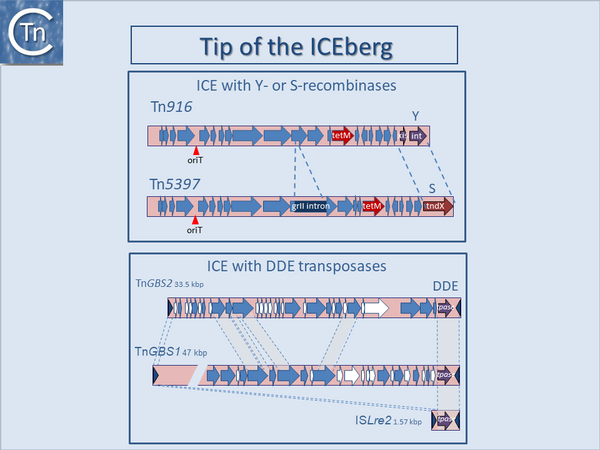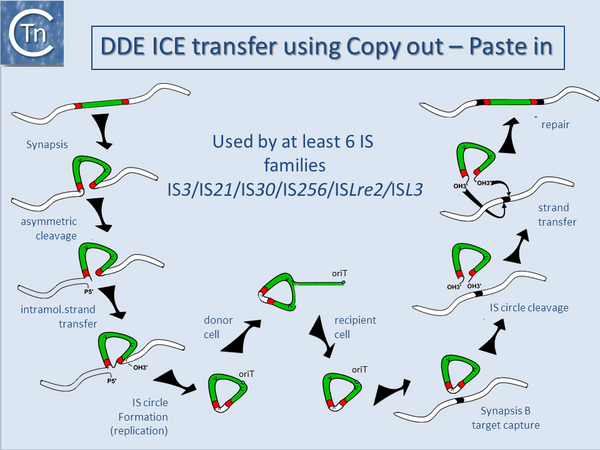General Information/IS related to Integrative Conjugative Elements (ICEs)
Other structures which obscure the definition of an IS have been identified among various TEs. For example, ICE (Integrative Conjugative Elements), are found integrated into the host genome but can excise and transfer from cell to cell. Their insertion into and excision from their host chromosomes is generally using a tyrosine-based integrase related to phage integrases[1][2][3] (Fig.1.7.1) while others possess a serine-recombinase (Fig.1.7.1) (Fig.1.16.1). Their transfer depends on a second set of proteins which includes a “relaxase”, often a single strand endonuclease of the HUH superfamily[4][5]. However, ISSag10, a tIS member of the IS1595 family from Streptococcus agalactiae which includes an O-lincosamide nucleotidyltransferase gene, encodes a DDE transposase, and undergoes cell-to-cell transfer when complemented with an autonomous ICE, Tn916[6]. In this case, a cryptic origin of transfer is located within the 3’ end of the resistance gene. These non-autonomous ICE have been called IME (Integrative Mobilizable Elements[7]) or CIME (CIs-Mobilizable Elements[8]).
More recent studies have identified a new ICE family, transposon of Group B Streptococcus (TnGBS), in which the enzyme catalyzing their integration and excision belongs to another DDE-group Tpase [9][10][11][12] (Fig.1.16.1). This led to the identification of an entirely new family of classic IS carrying DDE Tpases, the ISLre2 family[13]. Other ICE have been identified which include a DDE Tpase closely related to that of the IS30 family[14]]. It is important to note that the IS with these associated DDE transposases transpose using a copy-paste mechanism which involves a double strand transposon circle. ICE circles are presumably formed using this mechanism in contrast to those possessing tyrosine or serine recombinases. DDE-generated circular ICE would then undergo transfer using the specific relaxase system (Fig.1.16.2)
It seems likely that examples of ICE with other IS family Tpases are awaiting identification. Moreover, in addition to a variety of transfer functions, certain ICE carry plasmid-related replication genes important in ensuring sufficient stability of the transposition intermediates to enable their subsequent integration[15][16].
Early examples of ICE[17] were initially thought to be resistance plasmids and assigned an incompatibility group, incJ. These are maintained as an integrated copy in the host chromosome but can nevertheless give rise to circular copies[18]. This is yet another example of the increasingly indistinct frontiers between phage, plasmids and transposons[19][20][21] (http://db-mml.sjtu.edu.cn/ICEberg/).
Bibliography
- ↑ <pubmed>> </pubmed>
- ↑ <pubmed>12410819</pubmed>
- ↑ <pubmed>28482230</pubmed>
- ↑ <pubmed>12383726</pubmed>
- ↑ <pubmed>23832240</pubmed>
- ↑ <pubmed>17416666</pubmed>
- ↑ <pubmed>12568329</pubmed>
- ↑ <pubmed>15073287</pubmed>
- ↑ <pubmed>19183283</pubmed>
- ↑ <pubmed>23435978</pubmed>
- ↑ <pubmed>24418649</pubmed>
- ↑ <pubmed>23888872</pubmed>
- ↑ <pubmed>24418649</pubmed>
- ↑ <pubmed>19648240</pubmed>
- ↑ <pubmed>23435978</pubmed>
- ↑ <pubmed>19943900</pubmed>
- ↑ <pubmed>8586262</pubmed>
- ↑ <pubmed>10856646</pubmed>
- ↑ <pubmed>22009673</pubmed>
- ↑ <pubmed>12902278</pubmed>
- ↑ <pubmed>3016987</pubmed>

